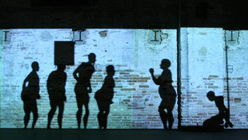Let me start by saying that I don’t believe you should put an arbitrary limit on the kinds of things that you make, and certainly never for the humdrum purpose of marketing your work. While it may be an idealistic, unpragmatic thing to say, I do believe that artmaking is the last bastion of real freedom. If you artificially restrain what you make in order to curry speculative favor with a narrow set of people who may or may not assist your career, you’ll only hurt yourself in the long run.

Paul Chan, Sade for Sade’s Sake, 2009.
That said, the other option is to continue making whatever you want, but be selective about what you show to the world. There’s no reason to put every last thing you’ve ever made on your website, as viewers might find it overwhelming or confusing, so slim it down to a manageable group of works. The first step is to take a really hard look at your oeuvre and select your strongest pieces or projects. Pretend you are starting from scratch with the new site and concentrate on quality over quantity. Be unsentimental! Make a list of these works as you go, and once you’ve gone through your images the next step is to figure out how you’re going to arrange or order them.
Surely there is a thread of conceptual continuity that runs through all of your projects, even if it’s sometimes hard to discern. Your job now is to find a way to emphasize that thread in the layout of your website. You might want to try using a standard outline for this kind of organizing because it mimics the architecture of most websites. For example:
1.) Oil on canvas, chiaroscuro
A.) work from 2012
i.) Sunset on Dragon Lake
ii.) The Coachman’s Dress
iii.) Grapes & Wicker
B.) work from 2011
etc.
You could arrange your projects by medium as you’ve done before, but you could also make an outline for a chronological organization, or by project or solo exhibition, or for particular concepts you’ve explored. If you try different ways of sorting, they might lead you to a new way of expressing the commonalities between your works. And if you really have a hard time doing all this with words on paper, you could try printing tiny images of your work and rearranging them on a wall or table until you find a combination that makes sense. Remember to keep an eye on cohesion and try to look at your distributions as a stranger would. As you go, just keep asking yourself, “Does this make sense?” If your final preferred grouping is nontraditional, make sure you have a solid justification for it.

Paul Chan, Constellation Series, Right to peaceably assemble (formerly Cassiopeia), 2005.
You can also unify the work with good site design, keeping the layout consistent from page to page. If you’re not creating a website using one of the popular template-based site builders, be sure that your font styles and sizes are the same throughout and that all your images are one standard width. Having a regular structure or format for each section will help, too. For example, if you arrange the site by project or exhibition, then in each section you could show an installation shot, then the individual works, and then a detail shot or two if the work warrants it; if you’re grouping your work by a medium like drawing, then you can establish a rhythm by consistently showing a sequence of overall shot, detail, overall shot, detail, etc. The goal here is to unite all the different works by establishing a background of uniformity in the site’s structure.
The other part of your site that can really help bring everything together is your statement. This is perhaps the hardest part, but when you are going through all your images and organizing them, think about the progression of your ideas and the way that one project has moved you to the next. What are the similarities between your works? What notions or concepts have you been following? The statement is the place where you can wrap it all up and put a bow on it, so don’t neglect this portion of your site.




